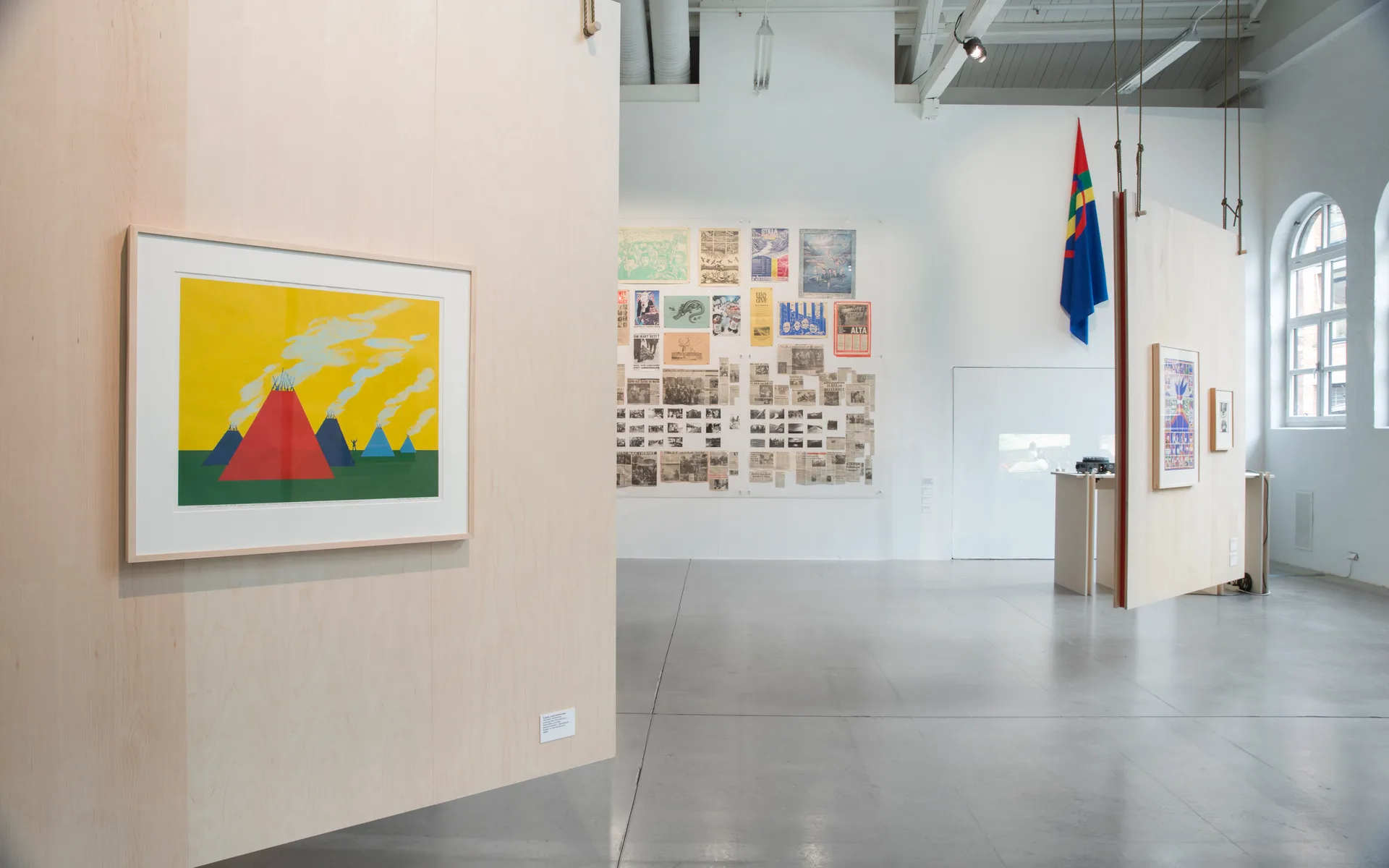
Let the River Flow. The Sovereign Will and the Making of a New Worldliness.
Nedre gate 7
Oslo
The Áltá Action (c. 1978-82) changed the course of Sámi and Nordic history. This exhibition showcased the role of Sámi artists in the Action, and the solidarity of non-Sámi counterparts. It also presented contemporary artistic positions, both Sámi and international, exploring the legacy of this eco-Indigenous uprising today, at a time of growing global Indigenous power.
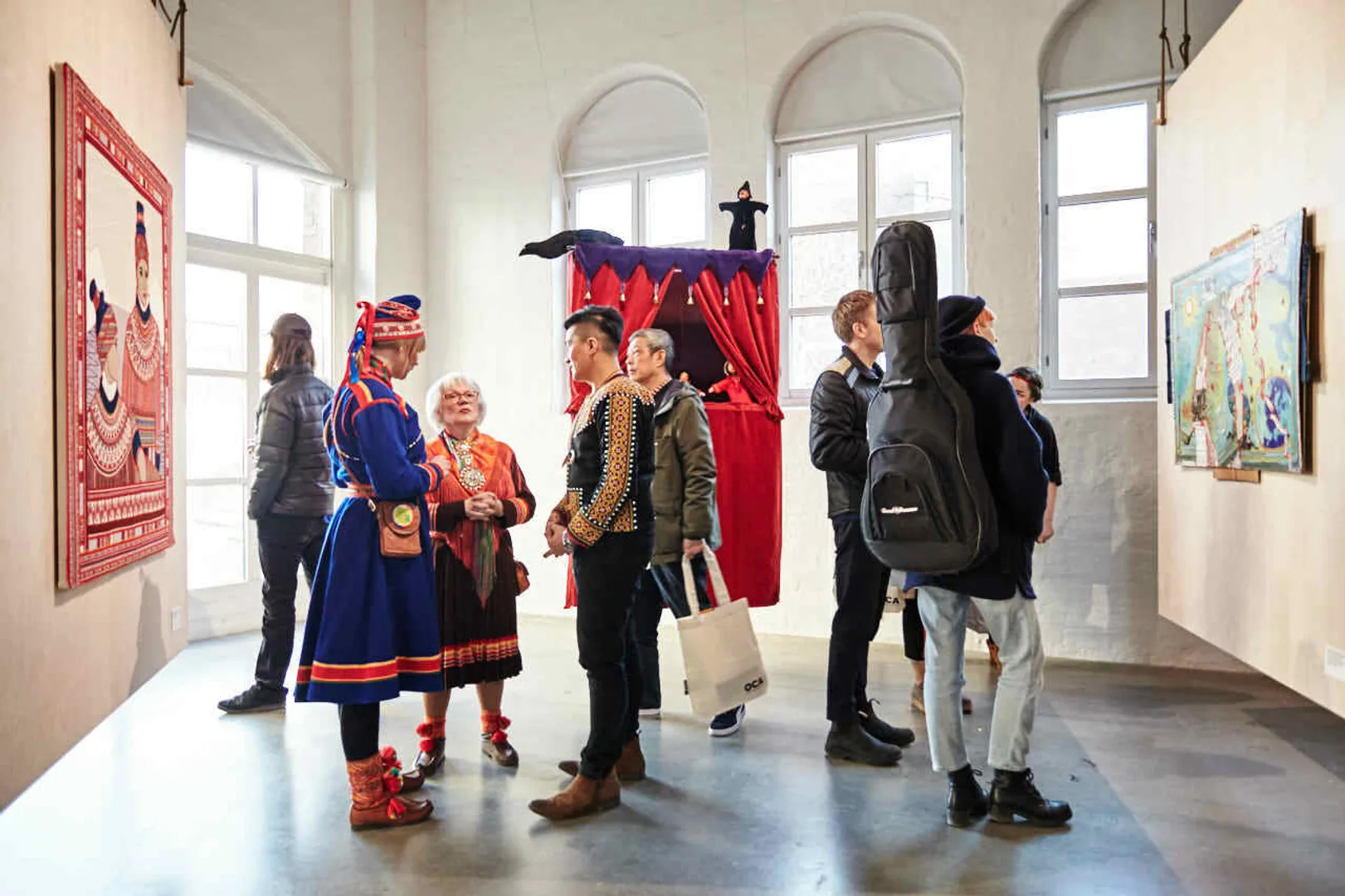
From the opening of 'Let the River Flow. The Sovereign Will and the Making of a New Worldliness'. Photo: OCA / Herman Dreyer
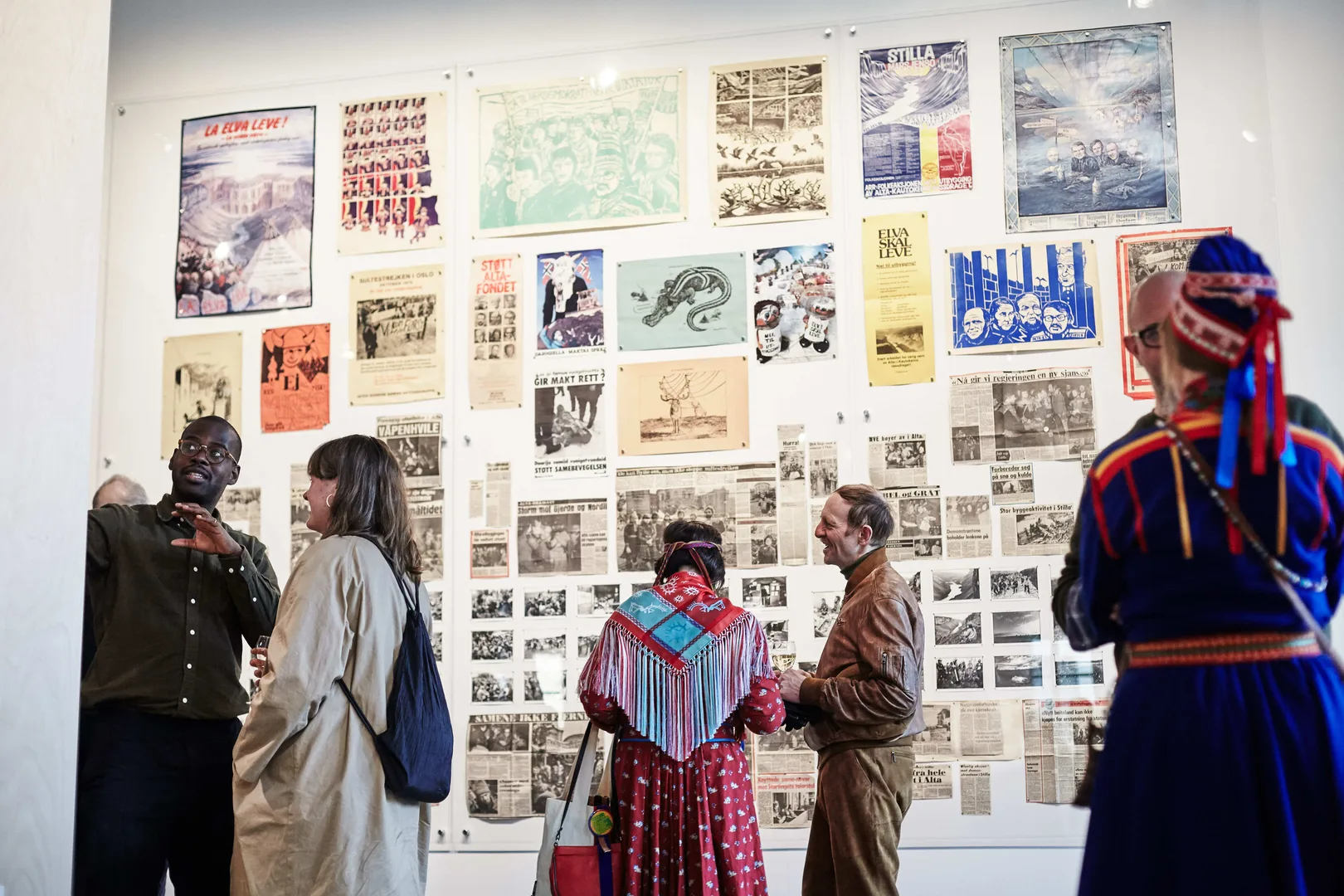
From the opening of 'Let the River Flow. The Sovereign Will and the Making of a New Worldliness'. Photo: OCA / Herman Dreyer
'Let the River Flow' was the fruit of three years of dialogue with artists, scholars, and other cultural peers and peoples across Sápmi, traversing four nation-states (Norway, Sweden, Finland and Russia). The exhibition showcased the essential role of Sámi artists in the action, in particular the radical Mázejoavku: Sámi Dáiddajoavku (Sámi Artists’ Group, 1978-83), as well as the solidarity of non-Sámi counterparts. It presented rare historic works side-lined by the Nordic art historical canon, as well as material from the The Archives of the Protest Movement against the damming of the Áltá-Guovdageino water system and new contemporary commissions that explore the legacy of Áltá today. 'Let the River Flow' simultaneously claims and challenges the place of Sámi art amongst the new global, modernist, museology dedicated to expanding the canon of art history to a worldwide scale.
'Let the River Flow' was curated by Katya García-Antón, with Antonio Cataldo. The project was honoured by the guidance of an Advisory Council consisting of Sámi scholars Dr Gunvor Guttorm and Prof Harald Gaski. The exhibition design was the fruit of a Sámi-Norwegian collaboration by A-Lab (Káre R. Anti) and Torsteinsen Design.
Artworks, performances and lectures were presented by: Nabil Ahmed, Áillohaš/Nils-Aslak Valkeapää, Maria Thereza Alves, Jimmie Durham, Elle Márjá Eira, Mai-Lis Eira, Pauliina Feodoroff, Aage Gaup, Trygve Lund Guttormsen, Josef Halse, Geir Tore Holm and Søssa Jørgensen, Berit Marit Hætta, Susanne Hætta, Iver Jåks, Keviselie/Hans Ragnar Mathisen, Áine Mangaoang, Britta Marakatt-Labba, Joar Nango and Tanya Busse, Rannveig Persen, Synnøve Persen, Máret Ánne Sara, Arvid Sveen, Elin Már Øyen Vister, amongst other contributors.
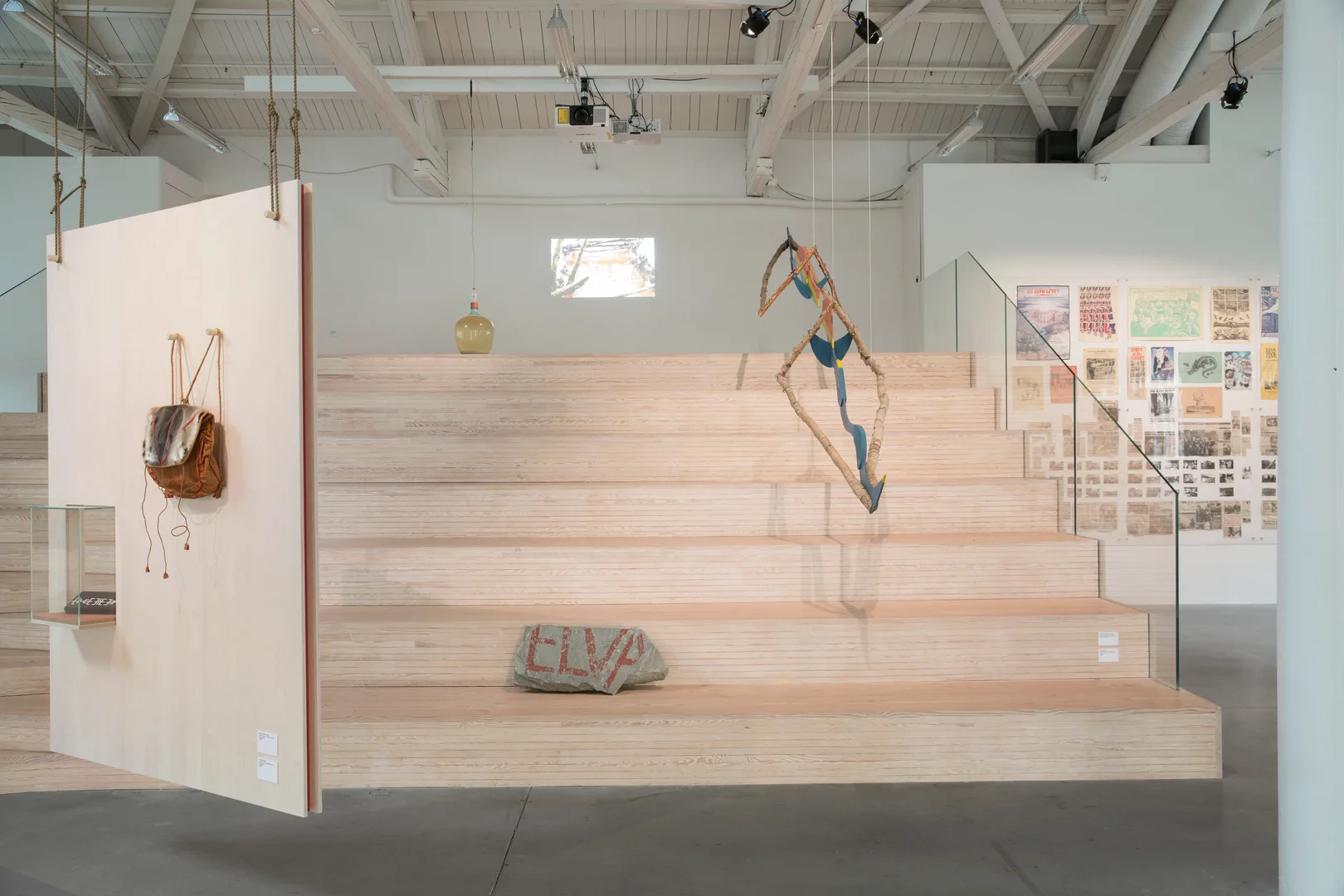
'Let the River Flow. The Sovereign Will and the Making of a New Worldliness' installation view. Photo: OCA / Herman Dreyer
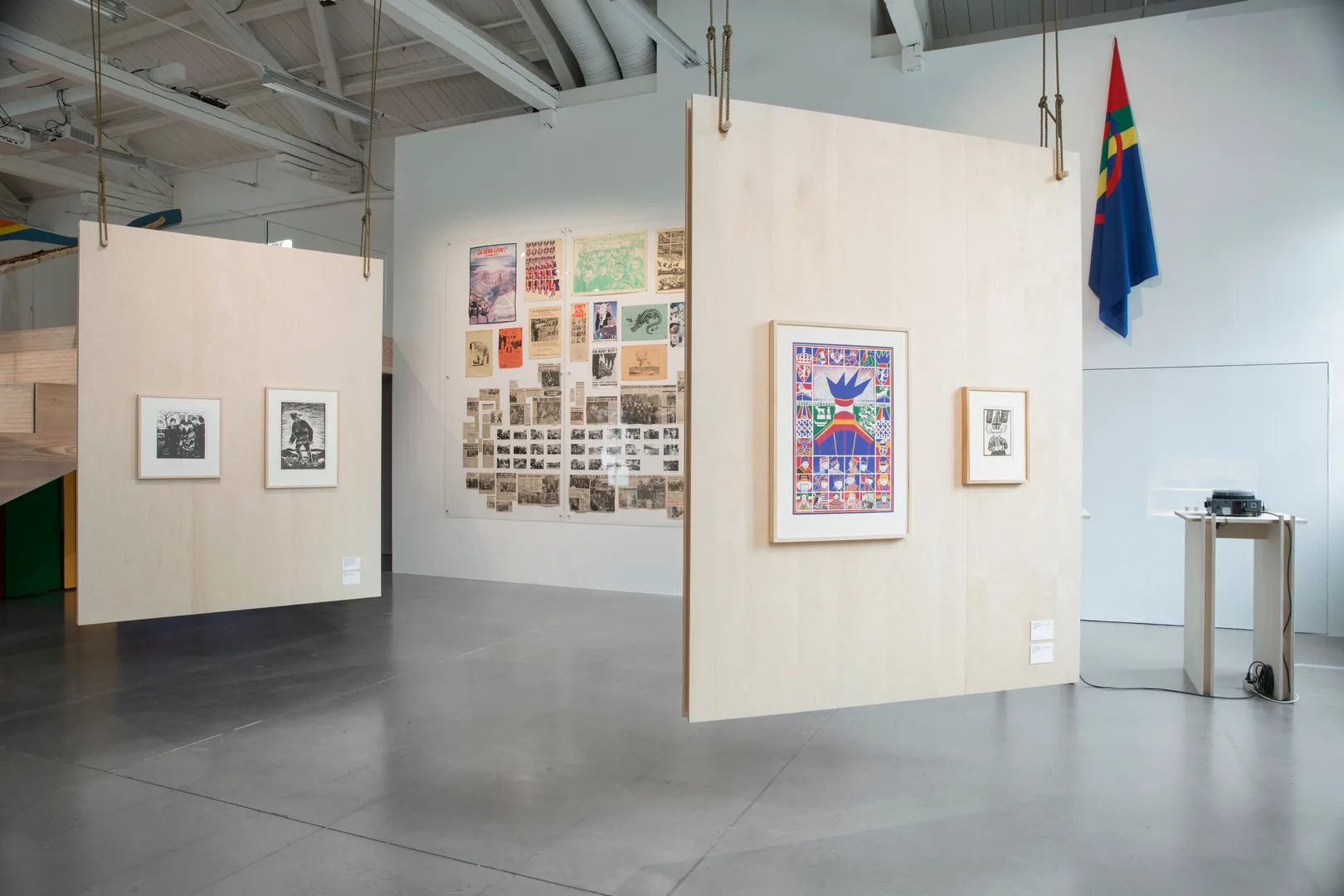
'Let the River Flow. The Sovereign Will and the Making of a New Worldliness' installation view. Photo: OCA / Herman Dreyer
Emerging histories of Indigenous empowerment
The Áltá Action was a reaction to the profound impact on Sámi communities, their livelihoods, their cultural heritage and role as environmental protectors, of the flooding caused by the damming of large areas of Sápmi. The resistance movement was as unprecedented within the history of social protests in Europe, as was its dramatic climax: the Sámi hunger strikes in Oslo in 1979. Moreover, it was part of the Áltá Action's new environmental consciousness of the 1970s, as well as the emerging histories of Indigenous empowerment of the time.
Today the Action elicits bitter-sweet memories. Some historians have claimed that by catalysing Norway's signature of the United Nation's ILO Convention 169 and the creation of a Sámi Parliament in Kárášjohka (1989) the Action marked a new era of Nordic de-colonisation - one that potentially placed Norway at the fore-front of social justice policy-making world-wide. Yet a new generation of Sámi artists and thinkers claim that this process stalled early on, coinciding with the rise of a new economy in Norway, and that the very survival of Sámi culture, land, livelihood and world-views is in serious danger today. Their voices are much sought after amongst the most prestigious cultural arenas internationally, and play an essential role within the powerful Indigenous movement spreading across the world – artistically, ecologically and politically.
Discursive Programme
12 May 2018:
A performative walk along the Holsbekken creek with facts, fiction, sound, language and speculation. As part of Holsbekken (RGB), a work by Geir Tore Holm and Søssa Jørgensen. Skiptvet, Østfold County.
27 May 2018:
A sensory walk and a concert promoting a deep listening to Áillohaš’sThe Bird Symphony. As part of Singing Along to Whooper Swans – Talking with the Rocks – Goase Dušše revisited by Elin Már Øyen Vister. Sinober, Lillomarka.
1 June 2018:
Fighting Environmental Crime in West Papua. A workshop organised by OCA in cooperation with UiT: The Arctic University of Norway as part of the exhibition, convened by the Tromsø Academy of Contemporary Art and Creative Writing. The workshop was led by Bangladeshi artist, writer and researcher Nabil Ahmedgave, together with Papuan nature guardians Mama Yosepha Alomang and Markus Haluk, London-based human rights campaigner Andrew Hickman, and human rights lawyers Veronica Koman and Fadjar Schouten-Karwa. The workshop centered on their recent research into environmental regulation, space and media practices and the law relating to the impact of mining in West Papua, as an environmental issue connected to current challenges across other Indigenous contexts, such as that of the Sápmi region. Contributions from Sápmi included Ande Somby, writer, yoiker (yoik is the Sámi way of singing or chanting; and the musical modus of yoiks differs from what is commonly known in Euro-American music) and Associate Professor of Law at UiT (Arctic University of Norway) where he specialises in Indigenous rights law and Hanne Hammer Stien graduated as an art historian from UiT The Arctic University of Norway (2004).
3 June 2018:
Closing Symposium within the exhibition on the issues of art, guardianship, land, nature and colonial consumption in relation to Indigenous artistic practices.
Presentations by Sámi author Marry Á. Somby on writing and literature in the staging of the Action; Sámi scholar Irene Snarby, contextualising the art of the legendary Sámi artist Iver Jåks (1932–2007) from a duodji perspective (a term mis-labelled as Sámi handicraft, which in fact encompasses a Sámi worldview, spirituality, Sámi knowledge, conceptions of nature and the making of objects in relation to life); renowned Māori curator Megan Tamati-Quennell presented central moments in recent Māori artistic production with particular focus on leading Māori artist Ralph Hotere and senior Māori artists Emily Karaka and Shona Rapira Davies; Oslo-based musicologist, educator and musician Áine Mangaoang spoke of the relationship between songs and protest; Sámi artist Pauliina Feodoroff presented her work at the intersection of ecological restoration and film; Sámi musician and yoiker Sara Marielle Gaup Beaska and radio producer Eva Maria Fjellheim presented thoughts on art and guardianship; London-based, Bangladeshi artist, writer and researcher Nabil Ahmedgave gave a talk, together with Papuan nature guardians Mama Yosepha Alomang and Markus Haluk, London-based human rights campaigner Andrew Hickman, and human rights lawyers Veronica Koman and Fadjar Schouten-Karwa spoke of their recent research into environmental regulation, space and media practices and the law relating to the impact of mining in West Papua, as an environmental issue connected to current challenges across other Indigenous contexts, such as that of the Sápmi region.
'Let the River Flow' at Tensta Konsthall
'Let the River Flow. The Sovereign Will and the Making of a New Worldliness' opened at Tensta Konsthall in Stockholm on 4 February 2019.
The iteration of the exhibition included a discursive programme with contributions from Gunvor Guttorm to discuss the concept of duodji, Sámi art and craft, and its effects on their everyday traditions, and how the duojarat (the artisans) use it in their creative processes and what kind of narratives they create; Katarina Pirak Sikku gave a talk on Julevädno – The Lule River; Søssa Jørgensen and Geir Tore Holm presented their work 'Stream Ripple – Our Inner River', and led a walk along the Igelbäcken.
'Let the River Flow' at Sámi Dáiddaguovddáš / Sámi Center for Contemporary Art
'Let the River Flow. The Sovereign Will and the Making of a New Worldliness' opened on 16 May 2018 at the Sámi Dáiddaguovddáš (SDG) in Kárášjohka. The SDG version of the exhibition was curated by Raisa Porsanger and managed by SDG Director Kristoffer Dolmen, presenting new seminars in Kárášjohka with Sámi peers.
'This year marks 40 years since the Áltá action and the first hunger strike in front of the Norwegian Parliament in Oslo. For many people in Finnmark and Sápmi this history is well known and so is its outcome: a firmer Sámi identity, a vaster environmental consciousness among both Sámi and Norwegian people, and the establishment of the Sámi Parliament. Today we see several conflicts about natural resources in Sámi areas, where the Áltá action is often referred to - both as a reminder and a warning.
In addition to the artworks shown at OCA and Tensta Konsthall, this exhibition shows two artworks connected to the Áltá action and the hunger strikes in Oslo,'
- Raisa Porsanger, Sámi Artist and Curator, 'Let the River Flow. The Sovereign Will and the Making of a New Worldliness', OCA, Sámi Dáiddaguovddáš, Kárášjohka.
Artworks presented by: Áillohaš/Nils-Aslak Valkeapää, Maria Thereza Alves, Jimmie Durham, Elle Márjá Eira, Mai-Lis Eira, Aage Gaup, Trygve Lund Guttormsen, Josef Halse, Geir Tore Holm and Søssa Jørgensen, Berit Marit Hætta, Susanne Hætta, Iver Jåks, Keviselie/Hans Ragnar Mathisen, Britta Marakatt-Labba, Joar Nango and Tanya Busse, Rannveig Persen, Synnøve Persen, Máret Ánne Sara, Arvid Sveen, Elin Már Øyen Vister, Ole Nesvik, Randi Marainen and Thomas Marainen.
'Let the River Flow' at Oarjje-Romssa Musea / Sør-Troms Museum
'Let the River Flow' opened at Oarjje-Romssa Musea / Sør-Troms Museum in Harstad on 2 february 2020. The Oarjje-Romssa Musea / Sør-Troms Museum version of the exhibition was curated by Raisa Porsanger and managed by SDG Director Kristoffer Dolmen, presenting new seminars in Kárášjohka with Sámi peers.
'This year marks 40 years since the Áltá action and the first hunger strike in front of the Norwegian Parliament in Oslo. For many people in Finnmark and Sápmi this history is well known and so is its outcome: a firmer Sámi identity, a vaster environmental consciousness among both Sámi and Norwegian people, and the establishment of the Sámi Parliament. Today we see several conflicts about natural resources in Sámi areas, where the Áltá action is often referred to - both as a reminder and a warning.
In addition to the artworks shown at OCA and Tensta Konsthall, this exhibition shows two artworks connected to the Áltá action and the hunger strikes in Oslo,'
- Raisa Porsanger, Sámi Artist and Curator, 'Let the River Flow. The Sovereign Will and the Making of a New Worldliness', OCA, Sámi Dáiddaguovddáš, Kárášjohka.
Artworks presented by: Áillohaš/Nils-Aslak Valkeapää, Maria Thereza Alves, Jimmie Durham, Elle Márjá Eira, Mai-Lis Eira, Aage Gaup, Trygve Lund Guttormsen, Josef Halse, Geir Tore Holm and Søssa Jørgensen, Berit Marit Hætta, Susanne Hætta, Iver Jåks, Keviselie/Hans Ragnar Mathisen, Britta Marakatt-Labba, Joar Nango and Tanya Busse, Rannveig Persen, Synnøve Persen, Máret Ánne Sara, Arvid Sveen, Elin Már Øyen Vister, Ole Nesvik, Randi Marainen and Thomas Marainen.
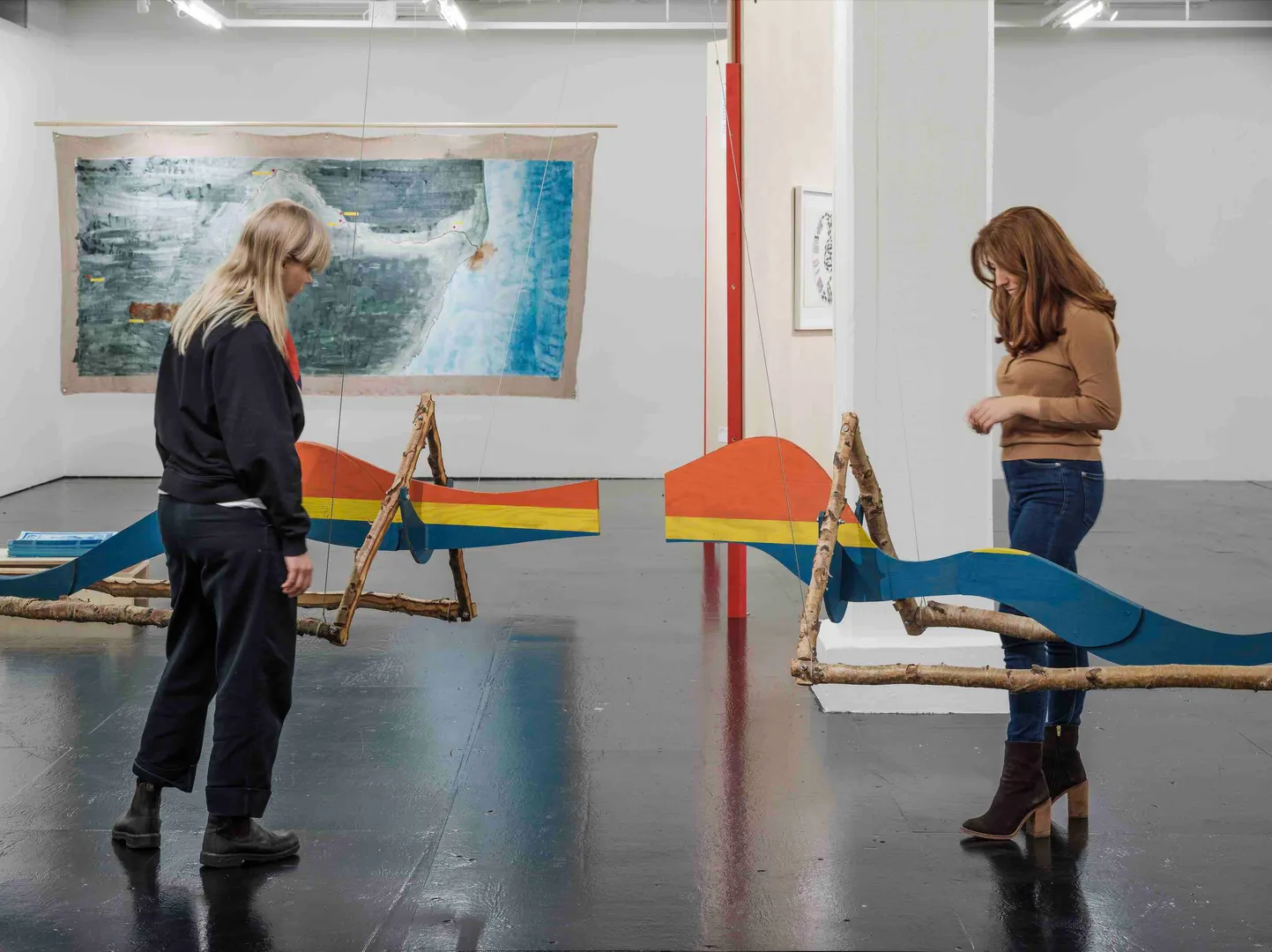
Installation view from the exhibition at Tensta Konsthal's exhibition space, 2019. Photo Tensta Konsthall.
Curator Raisa Porsanger and Katya García-Antón at SDG's exhibition space, 2019. Photographed by Eirin Torgersen / OCA.
Installation view from the exhibition at SDG's exhibition space, 2019. Photographed by Eirin Torgersen / OCA.